Published by The Heraldry Society
Posted by the Sept of the Knight de Bryan
Sir Charles Bryant-Abraham, the Knight de Bryan
The Chevalier Guy N. Bryan, KdB, FSAI Commilitonum Honorariorum Commissarius
Typed by Kim Bryan
Three Piles of Substance
By John Campell-Kease
Introduction
As mentioned in an earlier essay I live in a village called Hazelbury Bryan in the Blackmore Vale in Dorset. For centuries before the late Middle Ages, it was simply known as Haselbury (from the Anglo-Saxon Haesel-beorg, the high ground on which the hazel trees grow) the spelling being officially changed to Hazelbury as late as 1915.
The second portion of the name, which is what concerns us in this present essay, is that of a fourteenth lord, Guy de Bryan , who purchased both the manor and the advowson at Easter 1361 for 300 marks. Guy, Lord Bryan by writ of summons, and a Garter Knight, was a distinguished soldier who fought at Crecy and Sluys, and was a friend of King Edward III. Burke's General Armory blazons his arms as Or three piles conjoined in base azure although, as depicted later, the charges have also been shown with their longitudinal axes at right angles to the top edge of the shield rather than converging towards the base. Quite why the de Bryans chose the pile is not recorded although when we remember that it is regarded by some heraldists as a stylized representation of an arrowhead or the point of a lance rather than a stake or post used in bridge-building we probably need to look no further.
The first time the family is mentioned in England (in the person of Wydo de Brione) is around the year 1160 when they held land in Devon - indeed Torbryan in the county carries their name until his day. The first depiction of their arms which I have so far discovered (the family name is spelt Brienne) is in St. George's Roll, c. 1285, but they probably date from far earlier than this for the head of the family was already a powerful magnate in the reign of King John.
After about 1350 representations of the de Bryan arms became
many and various. Some of the oldest and most visually attractive
are contained in a stained glass window in a side chapel of
Slapton church (which the family endowed) in Devon. It contains
three shields of arms and seems to date from the 15th century. In
the centre is the shield of Sir Guy, Lord Bryan, on the left that
of his eldest son - also Sir Guy (1354-1386) bearing a cadency
mark of a label and, on the right, the shield of his second son
Sir William (who died in 1395), carrying not a crescent as we
might expect but a roundel. The most likely explanation for this
is that at sometime, possibly when the glass was being repaired,
the brisure was misinterpreted and a new but incorrect symbol was
fitted. A number of impressions of the seals of the father have
been preserved. One is comparatively simple but a second shows
the shield handsomely embossed and finely fretted, the whole
being supported by what may be wyverns and surmounted by a bird,
head towards the 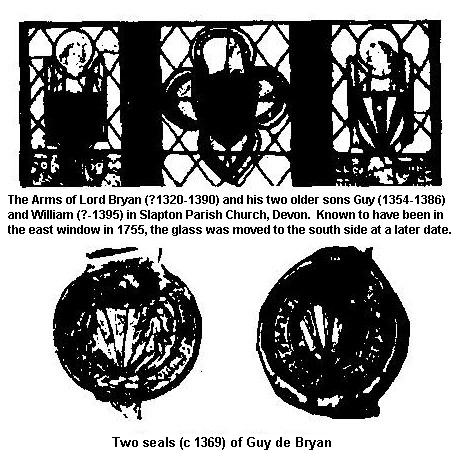 heraldic dexter and with wings
displayed. A third seal is that of the chantry college of Slapton
(which was founded and endowed by the de Bryans). It is a large
and vesica-shaped. In the centre the Blessed Virgin Mary - to
whom the college was dedicated - is represented under a rich
canopy, seated on a throne and crowned, supporting her son erect
on her right hand, and in her left hand a lily. Below, under a
semicircular arch, appears the founder on his knees, with his
hand joined upon his breast, and his shield of arms below him
with the legend "S. Coe. Collegii Guidonis de Briene de
Slapton."
heraldic dexter and with wings
displayed. A third seal is that of the chantry college of Slapton
(which was founded and endowed by the de Bryans). It is a large
and vesica-shaped. In the centre the Blessed Virgin Mary - to
whom the college was dedicated - is represented under a rich
canopy, seated on a throne and crowned, supporting her son erect
on her right hand, and in her left hand a lily. Below, under a
semicircular arch, appears the founder on his knees, with his
hand joined upon his breast, and his shield of arms below him
with the legend "S. Coe. Collegii Guidonis de Briene de
Slapton."
Towards the end of his life Sir Guy caused to be built in Tewsbury Abbey a magnificent tomb chest carrying his effigy and bearing on its sides representations of his shield. The effigy is clothed in the armour of the day, and Guy is shown in the act of sheathing or, conceivably, drawing, his sword - it is impossible to be certain for the arms and hands of the figure, and the sword have long since disappeared. The effigy wears over the armour, a surcoat or jupon. When originally installed the figure was richly painted - the chain-mail shows signs of diapering - and the over-garment was coloured with the nobleman's arms, stretching from the shoulders to well below the waist. An interesting point is that Guy de Bryan was not buried in Tewksbury at all , he was laid to rest in Slapton - but the circumstances are another story, unrelated to the present essay.
Sir Guy seems to have married twice; we need not be concerned with his possible first wife, but his second, if such she was, was Elizabeth Montacute, daughter of William de Montacute, earl of Salisbury and her mother had been a Grandison. Elizabeth had married twice before (to a Despenser and a Badlesmere) and the de Bryan connections with Tewksbury arose from her second marriage. In the Bodleian library is a fifteenth century memorial roll of benefactors of Tewksbury Abbey. It is handsomely illuminated and identifies Guy de Bryan and Elizabeth fairly prominently. The shield of arms displayed is the marital, impaled, coat of de Bryan and his wife. His arms show the three piles, while her half of the shield is quartered Montacute (argent three lozenges in fess gules) and Monthermer Or an eagle displayed vert membered and beak gules. It is interesting to note that the tinctures of the dexter, de Bryan, half of the shield have been reversed and the depiction is azure three piles conjoined in the base or. This style appears nowhere else so far as I am aware, so it is fairly safe to assume the illuminator simply got it wrong. The shield is plainly marked "Guydo de Brien miles" and "Elizabeth" so we are clearly looking at the right people.
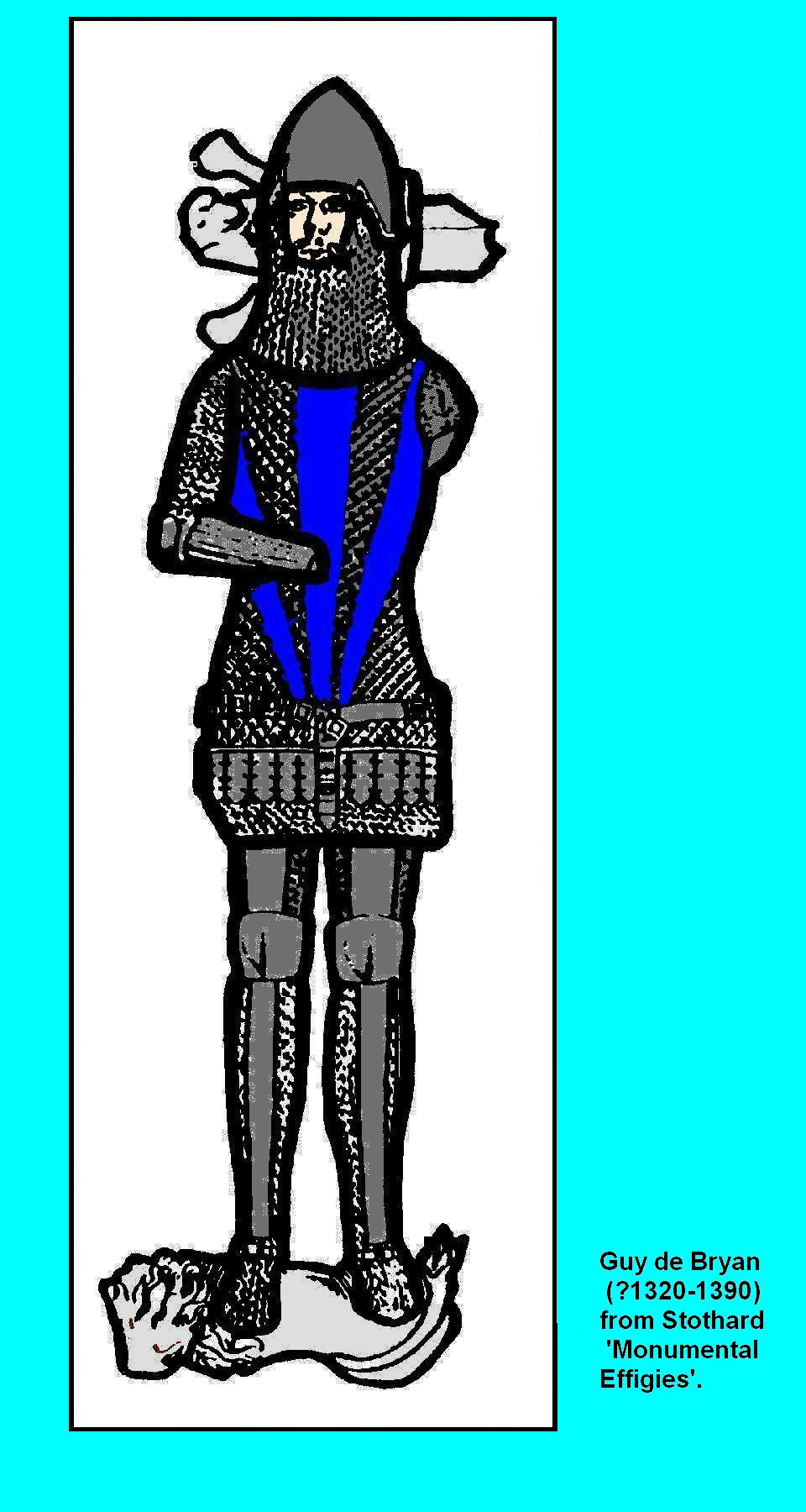
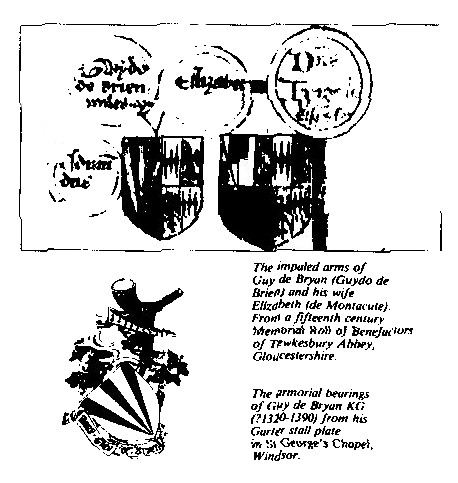
The arms of de Bryan appear in many places, and their very locations are interesting clues to both the historian and the armorist, who is seeking to increase his knowledge of the family and its marital connections. They are to be found in obvious places such as in Hazelbury Bryan and Torbryan churches, and on a stall plate in St. George's Chapel, Windsor surmounted by Sir guy de Bryan's crest: On a chapeau gules turned up ermine, a hunting horn sable garnished Or, for, as I have said, Guy de Bryan was an early Knight of the Garter. They appear on the front of the gallery in St. Saviour's church Dartmouth - no great mystery this for Dartmouth was held by the de Bryan family; they are on a handsome memorial brass in Seal in Kent, to Sir William de Bryan who was lord of Seal and Kemsing in that county - having inherited the manors from his grandmother Lady Grandison. They may be seen in Exeter cathedral on a Courtney tomb impaled with Courtney - Guy de Bryan's only undoubted daughter, Margaret, married, as her first husband, Hugh de Courtney (Her second husband was Sir John Erleigh of Somerton Erleigh).
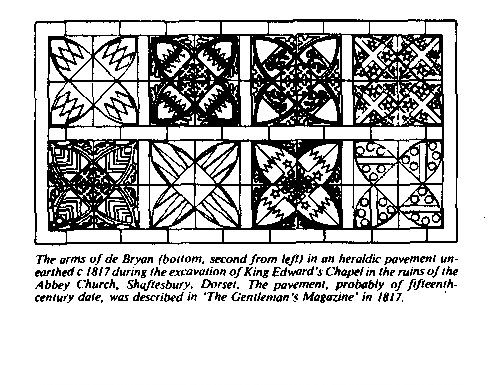
The de Bryan arms are in the cloisters in Canterbury Cathedral, in stained glass in Laugharne church, were found on encaustic tiles in Shaftesbury Abbey (in the company of those of many other west county worthies) and finally, they may be seen on two windows in York Minster. This last is a splendid example of how heraldry can point the student in unthought-of directions for at the time of writing I have absolutely no idea why the arms should be displayed there, there being no record of which I am aware of any de Bryan interests in the northern county. Some other family may be indicated?
Some years ago I wrote a short book on the history of the de Bryan family between the years 1160 when they first appear in Devon and 1456 when the last heiress in direct line died; since then I have from time to time noted clues as to what happened to members of cadet branches after that period or have come upon information which may or may not be relevant. And this is where the mysteries begin.
The Evidence
Among the older histories is one by Edward Halstead dealing with Kent, and published in 1797. In it is a note that at the time of King James I (1603-1625) William Bryan, Esqre. son of John Bryan of Knibworth in Leicestershire by Elianor, sister of John Bryan of Chichester, resided at Wrotham in Kent and bore for his arms Or three piles azure a chief ermine. There is no mention as to whether the piles were conjoined in a point. Wrotham, it may be noted is very close to Kemsing and Seal where, in the 14th century, Sir William de Bryan was lord. It is also, perhaps, relevant to take cognisance of the fact that around 1420 another William Bryan was a gentleman of Canterbury. Although there seems to be no record of his arms, Burke's General Armoury 1842 notes for both Kent and Leicestershire a variation of Bryan arms blazoned: Or, three piles azure a canton ermine and define the crest as: On a garb, lying fesse ways, a bird, and we may recall the bird displayed on one of Guy de Bryan's seals. There may be a connection.

If we now look to Burke's General Armoury again we see that in addition to the two sets of arms for Bryan already mentioned, no fewer than twenty further entries in the name - two with variant spellings. Such differences are always a problem to the student of heraldry and genealogy, and over the years I have identified fifteen ways of spelling the name Bryan from it's first appearance in the rolls as "Brione."
Although it is well known that Burke's is unreliable and attributed only a few of his sources, he is a useful starting point. Thus, presuming the blazon of Guy de Bryan to be the definitive verbal description of the achievement of the principle bloodline, the first minor difference we have is in the crest. In one instance, over a shield of Or, three piles azure, Burke notes a slightly different adornment: On a chapeau gules, turned up ermine a buglehorn or, tipped and garnished sable, sans strings. In other words the tinctures of the horn and virols are reversed. Next we have a shield of Or, three piles azure (and again we are not told if they are conjoined at the base, though I have assumed so), carrying a canton paly of six argent and gules, a bend sable charged with three eagles displayed of the field. These latter bearings, are those of an important branch of the Grandison family, from whom the children of Guy de Bryan were descended in the female line. In Lincolnshire we are told a family of Bryan displayed Or, three piles meeting near in the base azure within a bordure engrailed ermine.
Now we have a slight change of tincture. The records show men of the name in Devonshire and Gloucestershire with three piles azure in a field of silver, in Bedfordshire the field is gold the piles are vert, there is a record of argent three piles vert, and argent three piles wavy vert within a bordure azure, an annulet or, a seeming case of a fifth son of a minor branch. From County Wexford there is a record of argent, three piles gules with a crest of a saracen's head erased at the neck sable. Then, finally, we come to the last instance in this group: to yet another William Bryan, Deputy Ulster King of Arms, in the second half of the 18th century. For the year 1766 his arms are entered in the register of the College of Arms, in Irish Grants, Vol A, page 47 and may be blazoned argent three piles gules. The same arms are given for a Bryann (sic) in a late sixteenth century Irish armorial and also appear as the second quarter of the arms of the O'Brien family (variously barons and earls of Inchquin, and earls and marquesses of Thomond in the sixteenth to nineteenth centuries).
Even thus far I am sure readers will appreciate the wealth of information that is waiting to be uncovered regarding the de Bryan family, their cadet branches and perhaps people who, in later centuries, assumed, inherited or appropriated versions of the arms. The basic design of three piles is the device which may yet hold a whole study together. But there is still much more ground to be explored.
If we now move to consult Papworth's Ordinary of British Armorials we find that the de Bryan/Bryen family, their descendants or imitators were not the only ones to adopt the three piles so far discussed. There were at least three other families of considerable note in addition. In the 13th century the arms of John le Scot, Earl of Chester, were (according to Burke) Or, three piles gules. Also according to Burke the earldom became extinct in 1244 but this is wrong. Le Scot died childless in 1237 and the earldom was annexed to the Crown. Perhaps because of this last I can find no other member of this family (which related to the Scottish royal house) who assumed or bore the shield of the arms described, and we may move on.
Today, Lord Home of the Hershel (the former Earl of Home/Sir Alec Douglas- Home) carries in the second and third grand quarters of his arms, argent three piles gules marking the lordship of Brechin in Scotland, although Burke blazons the shield of that fief as Or, three piles in point gules which, given that we can place any reliance on Burke, is an interesting variation as will be shown. Sufficient for the present to observe that the coincidence of argent, three piles gules for Bryan of Wexford and the lordship of Brechin is quite probably of no significance and unlikely to confuse the armorist, although it is not so easy lightly to dismiss the similarities between the coats of le Scot and the lords of Brechin.
We may now move on to consider the arms of the Basset family and the ancient house of Ridel. From an early date, and in several counties, the arms of Basset closely resemble those of le Scot, and bear a resemblance so far as design is concerned to Bryan such to pose interesting questions to the heraldist and cause confusion to the historian. The arms of Basset of Weldon are blazoned Or three piles gules within a bordure sable bezantee. Basset of Drayton (of the time of King Edward III) Or three piles the points meeting in base gules a quarter ermine. A further branch of the family employed Or three piles sable at about the same time (and these, of course, come very close to the fourteenth century Or three piles azure of de Bryan). These arms, charged with three piles, were not, however, the original arms of the Basset family, they belonged to the house of Ridel. The two families had been close for along time. The first record known to me describes how, in the year 1106, Geoffrey Ridel (died 1120) acted as a commissioner with Ralf Basset and other leading men in the matter of sanctuary at Ripon. A later Geoffrey Ridel (died 1189) was bishop of Ely and siding with Henry II, played a leading part in the quarrel between the king and Thomas a Becket. Around this time, perhaps a little later, the date is uncertain, Maud Ridel married Richard Basset and the family connections were made.
The original arms of Basset were, according to Sir William Dugdale's The Usage of Arms, of the kind capable of being blazoned undie (that is to say barry wavy) but by the time of Edward III all cadet branches of Basset had invested themselves into Ridel, from their first adoption of the "3 piles of Ridel" at an earlier indeterminate date. The arms did not, however, remain wholly with Basset, for also in the reign of King Edward III, around 1348, they were adopted by Sir Hugh Wrottesley (a founder Knight of the Garter) who, being a grandson in the female line of a Basset of Drayton took unto himself Or, three piles sable. Yet another branch of Basset displayed Or, three piles meeting in the base of the escutcheon sable within a bordure argent bezantee. If we now compare this last with the arms defined by Burke as Bryan of Bedford (Or, three piles meeting near in the base, vert within a bordure azure bezantee) we might easily be forgiven for thinking that we were looking at the shields of closely related branches of the same family, but I can find no direct line between the Bassets and the Bryans - true, they were slightly related by marriage through the Fitzpaines, Greys of Codnor, de la Poles and Courtneys, but the links are by no means close.
The matter becomes even more puzzling when we realise that the generations of Ridel/Basset and de Bryan were contemporary, and that in the second half of the 14th century Ralph Basset of Drayton and Guy de Bryan were both summoned to Parliament and both gave evidence before the Scrope and Grosvenor enquiry into the identical charges and tinctures borne by Richard le Scrope and Robert Grosvenor. Then when we take into account that about this time Sir Hugh Wrottesley was also a Knight of the Garter we have three members of that distinguished Order with the following shields or arms: Wrottesley a founder knight of the Order in 1348, bearing Or, three piles sable which he took in honour of his maternal grandfather. Basset of Drayton elected to the Garter in 1368 and bearing Or, three piles gules a quarter ermine. Bryan of Woodsford (Sir Guy de Bryan) elected to the Order in 1369 whose shield was Or, three piles azure.

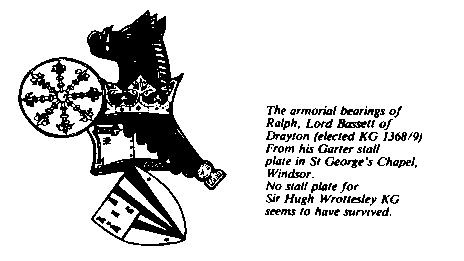
As I have said, I can find nothing to link the Bassets and the Bryans and no link between either of those families and that of le Scot. The questions mount and possibly the most intriguing is why did so many families choose three piles as the ordinaries? Perhaps for the reasons outlined at the beginning of this essay or simply, because "they were exceedingly graceful". The Salbornes (or Salbrons) may have thought so too when they adopted Azure three piles Or and just to be different (or the same), Or, three piles Azure bezantee.
References and Notes
The Arms of de Bryan.Coats of Arms No. 154, Summer 1991. The spelling Haseberge occurs in AD 1201 as does Haselbere which could point to an alternative interpretation of the "hazel wood". The matter may never be resolved. The earliest spelling known to me is de Brione but whether that identifies the commune of Brionne or Brion is uncertain. Stothard's Monumental Effigies contains an excellent rendering. See The Arms of de Bryen and de Moyon/Mohun as noted in 1, above. Bobleian, Lat, misc.b.2.r. An alternative, but less tenable, interpretation of the quartered half of the shield is that the second and third portions are not Monthermer but a known variation of Grandison with the tinctures reversed. Monthermer bore Or an eagle displayed vert but the Tewksbury roll could as easily have been painted Or an eagle displayed azure given the similarity between green and blue on some documents of that age. In the floor of the chancel to the north of the altar. It is inscribed "hic jacet DNS Willms de Bryene Miles quondam DNS de Kemsyng I de Sele quit obiit xxiii de mensis September anno dni MCCCLXXXXV cuiuc aie ppiciet Deus Amen." An earlier Sir Guy (probably Lord Bryan's father) is said to have given a charter to the Corporation of Laugharne, the terms of which govern that body to this day. The arms of Bryan are still used as those of the Corporation. Volume V, page 52 They are listed in No. 154 of the Coat of Arms, on page 67. To which may be added Breheyn (Collins Roll, c. 1295), and Breheyn (Lord Marshall's Roll, c. 1310). Monasticon Anglicanum A New Dictionary of Heraldry by Stephan Friar, A & C Black, London, (1987). The reader who is sufficiently intrigued is referred to pp 1026-1031 of Papworth's Ordinary for many other examples of the adoption of three piles as charges, and to pp 516-518 of Anglo-Norman Armory, Two by Cecil Humphrey-Smith (Kent, 1984).
A Question about "Three Piles of Substance"
From Mr. Joseph Biddulph
Sir: In reference to the article by John Campbell-Kease in N.S. No. 164 I should like to add a bit more about Bryan and Basset. I recently borrowed from inter-library loan the most impressive Development of Welsh Heraldry Vol. I, by Michael Powell Siddons (National Library of Wales, Aberystwyth, 1991, ISBN 0 907158 51 X): this unfortunately had to go back, but in my notes I see that there is a Sir Guy de Bryan, circa 1255, Lord of Tal-lacharn (Laugharne, Carmarthenshire), with the arms azure, three piles conjoined in point or. Could this be the Guy whose arms are illustrated in p. 127, or perhaps the reversed tinctures have been influenced by the usage of the Laugharne branch of the family? I should add that connections between families in the northern part of Gloucester and the Advenae of South Wales are very numerous - witness the placename Walton Cardiff. A large chunk of land near Pontypridd was owned by Tewksbury Abbey: we only need another bit nearer to Laugharne to see that these Bryans too could have been benefactors of the Abbey. Moving on to the Bassets: they were long associated with Beaupre, St. Hilary, in the Vale of Glamorgan: here I can recommend another source in Anthony L. Jones's superb sites Heraldry in Glamorgan. At Beaupre the Basset arms are: Argent, a chevron between three bugle horns sable. Rather cryptically this is recorded in Siddons, pp. 376- 377 in a list of "the Conquerors who came to Glamorgan" as:
Based ef a ddwc tri chorn o sabl tri gwregys sable kwpwl or un ryw.
"Basset: he bears three horns of sable, three scallops sable, a chevron of the same color."
The three bugle horns of Basset and the piles of Bryan appear in the rather liberal quartering of the native Welsh heraldry, I believe. According to Ekwall's Oxford Dictionary of English Placenames (under Brampton Bryan) Brian is a Norman Christian name of Breton origin. Hazelbury's Bryan Ekwall derives from Brienne "in France". I would like to know if there is still an armigerous family of the name in France and , if so, what arms they bore.
Yours faithfully,
Joseph Biddulph
32 Stryd Ebeneser Pontypridd, Cymru CF37 5PB December 22, 1993
Reply from Mr. John Campbell-Kease
Sir: I am pleased to have an early opportunity to respond to Mr. Biddulph's letter of December 22. There were at least nine generations of de Bryan men between c. 1115 and 1386 with the Christian name Guy. In the thirteenth and early fourteenth centuries the members of the family were indeed Marcher Lords, as perhaps Mr. Biddulph implies, with extensive lands in "West Wallia and Pembroke". An Inquisition post Mortem of 1307 following the death of Guy V (c. 1250-1307), husband of Sibille de Sully, lists no fewer than fifty-five holdings centred around the family's Tallaherne villa and its two hundred and sixteen burgages. The Guy de Bryan (Guy VIII) commended in the Tewksbury Abbey tool (and who was married to Elizabeth) lived from c. 1320-1390 as dealt with my essay. His Gloucester estates were in jure uxoris, the lady being previously wife to a member of the Badlesmere family (as I mentioned on p. 125 of the C. of A. No. 164) with whom, incidentally, she is buried in Tewksbury Abbey. The guy de Bryan referred to by Mr. Biddulph is most certainly Guy IV (p. 1215-c. 1268) whose wives were Eve de Traci and Joan de la Pole. Eilert Ekwall was wrong in saying "Hazelbury Bryan" derives from a likely family from Brienne in France. It comes from the family of de Bryan who hailed from Brionne (or Brion) as witness the earliest spelling of the family name (see my essay, p. 123). I have sometimes been tempted to hazard that the de Bryans were descended from Gilbert, Count de Brionne of Brittany, (murdered AD 1040), ancestor to the de Clares who may have been involved in the death of William Rufus, but have never quite dared. The confusion with Brienne is orthographical in origin and also in the desire of some writers to try to link the de Bryans with John de Brienne, King of Jerusalem (1210-1224), and his crusading kinsmen but there is no evidence to suggest the slightest connection. I cannot comment on the Bassets and their bugle horn charges or even hazard if they were of the same blood as the men who adopted the "3 piles of Ridel" mentioned on p. 131 of C. of A. 164; they lie outside my field of study. Also beyond the area of my labour is the application of the Celtic Christian name Brian which, according to the appropriate Oxford dictionary, is of doubtful etymology.
Yours truly,
John Campbell-Kease
Pleck Farm House, Hazelbury Bryan, Sturminster Newton, Dorset DT10 2EE January 7, 1994